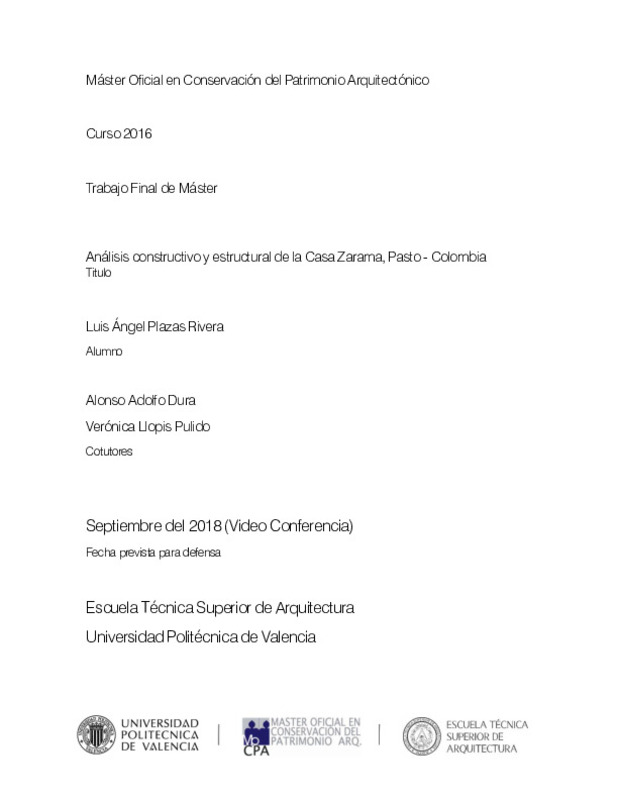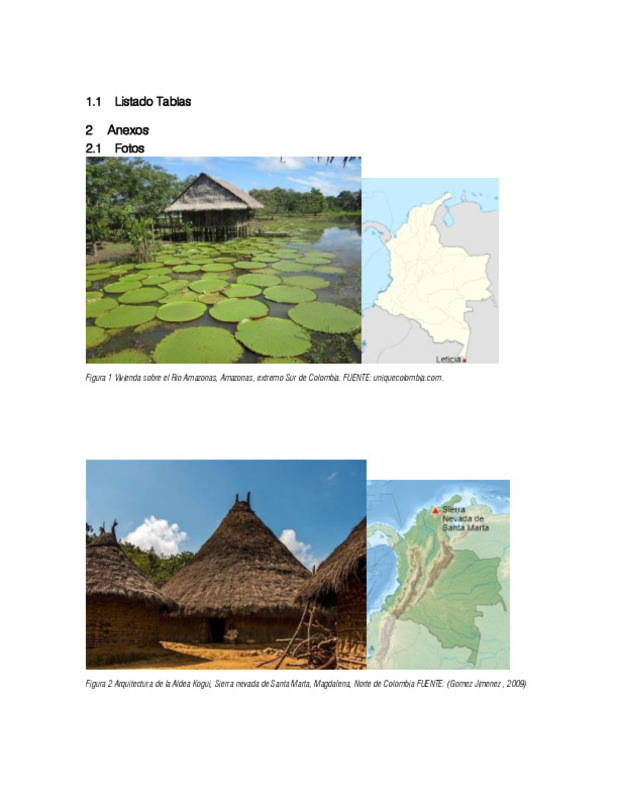JavaScript is disabled for your browser. Some features of this site may not work without it.
Buscar en RiuNet
Listar
Mi cuenta
Estadísticas
Ayuda RiuNet
Admin. UPV
Análisis constructivo y estructural de la Casa Zarama, Pasto - Colombia
Mostrar el registro sencillo del ítem
Ficheros en el ítem
| dc.contributor.advisor | Llopis Pulido, Verónica Mª
|
es_ES |
| dc.contributor.advisor | Alonso Durá, Adolfo
|
es_ES |
| dc.contributor.author | Plazas Rivera, Luis Angel
|
es_ES |
| dc.coverage.spatial | east=-77.2786501; north=1.2137684; name=Cra. 24 #1770, Pasto, Nariño, Colòmbia | es_ES |
| dc.date.accessioned | 2018-12-26T09:25:11Z | |
| dc.date.available | 2018-12-26T09:25:11Z | |
| dc.date.created | 2018-09-18 | |
| dc.date.issued | 2018-12-26 | es_ES |
| dc.identifier.uri | http://hdl.handle.net/10251/114402 | |
| dc.description.abstract | Colombia se encuentra localizado en la zona andina, punto en el cual convergen múltiples capas tectónicas, convirtiendo esta en una de las regiones con mayor actividad sísmica en la tierra. Testigo de esto son los terremotos ocurridos en el eje cafetero en 1999, Popayán en 1983 y Cúcuta en 1821; Los cuales provocaron el colapso de múltiples estructuras, generando pérdidas incalculables. Gran parte de los centros históricos colombianos fueron construidas en tierra, utilizando técnicas heredadas de la invasión española; como son las edificaciones de tapia, bahareque y adobe; materiales que tiene una respuesta deficiente ante esfuerzos de tensión y cortante. La continua amenaza sísmica de la zona, la materialidad de estas estructuras, las múltiples intervenciones y cambios de usos que se le han dotado a estas edificaciones a lo largo del tiempo, hace que estas construcciones sean altamente vulnerables ante un evento sísmico, poniendo en riesgo la vida y los bienes de los habitantes. Por lo que se debe plantear soluciones que mejoren su desempeño estructural ante este tipo de acontecimiento, que sea respetuosa con los valores patrimoniales del edificio, como parte de la memoria histórica del país. Esta tesis tiene como fin el estudio y la compresión estructural de este tipo de arquitectura, ante las cargas sísmicas y de servicio. Mediante la implementación de metodología avanzada de cálculo y software especializado, se analizará el comportamiento estructural, simulando múltiples hipótesis ante un eventual terremoto. De esta forma proponer soluciones que mejoren el desempeño estructural, minimizando su vulnerabilidad sísmica. Como fin practico de este TFM se estudiará el caso específico de la Casa Zarama; una antigua casona de estilo republicano, de dos pisos y 2200 m2 de área, construida en tapia pisada a principios del siglo XVIII, ubicada en el centro histórico de la Ciudad de Pasto, capital de Nariño (sur de Colombia). | es_ES |
| dc.description.abstract | Colombia is located in the Andean Zone, a point at which multiple layers converge Tectonics, turning this into one of the most seismically active regions on Earth. Witness Of this are the earthquakes occurring in the coffee axis in 1999, Popayán in 1983 and Cúcuta in 1821; Which caused the collapse of multiple structures, generating incalculable losses. Much of the Colombian historical centers were built on land, using technical Inherited from the Spanish invasion; such as the buildings of Tapia, Adobe and Adobe; Materials that have a poor response to stress and cutting efforts. The continuous seismic threat of the area, the materiality of these structures, the multiple Interventions and changes of uses that have been endowed to these buildings over time, Makes these constructions highly vulnerable to a seismic event, putting in Risk the life and property of the inhabitants. Therefore, solutions should be raised to improve their Structural performance before this type of event, which is respectful of the values Heritage of the building as part of the historical memory of the country. This thesis aims to study and the structural compression of this type of architecture, before the Seismic and service charges. By implementing advanced calculation methodology and Specialized software, the structural behavior will be analyzed, simulating multiple hypotheses In the event of an earthquake. In this way propose solutions that improve the performance Structurally, minimizing its seismic vulnerability. As a practical purpose of this TFM will study the Specific case of the Zarama house; An old house of Republican style, two floors and 2200 m2 of area, built in Tapia treaded at the beginning of the eighteenth century, located in the historical center of the City of Pasto, capital of Nariño (southern Colombia). | es_ES |
| dc.format.extent | 298 | es_ES |
| dc.language | Español | es_ES |
| dc.publisher | Universitat Politècnica de València | es_ES |
| dc.rights | Reconocimiento (by) | es_ES |
| dc.subject | Mechanical damages | es_ES |
| dc.subject | Damage models | es_ES |
| dc.subject | Modelo de daños | es_ES |
| dc.subject | Daños mecánicos | es_ES |
| dc.subject | Building structures | es_ES |
| dc.subject | Estructura de un edificio | es_ES |
| dc.subject | Pasto (Colombia) | es_ES |
| dc.subject | Arquitectura colombiana | es_ES |
| dc.subject | Casa Zarama | es_ES |
| dc.subject | Construcción histórica | es_ES |
| dc.subject | Análisis sísmico | es_ES |
| dc.subject | pushover | es_ES |
| dc.subject | MEF | es_ES |
| dc.subject | Historical construction | es_ES |
| dc.subject | Analysis seismic | es_ES |
| dc.subject | Continuum damage mechanics | es_ES |
| dc.subject | FEM | es_ES |
| dc.subject.classification | MECANICA DE LOS MEDIOS CONTINUOS Y TEORIA DE ESTRUCTURAS | es_ES |
| dc.subject.other | Máster Universitario en Conservación del Patrimonio Arquitectónico-Màster Universitari en Conservació del Patrimoni Arquitectònic | es_ES |
| dc.title | Análisis constructivo y estructural de la Casa Zarama, Pasto - Colombia | es_ES |
| dc.type | Tesis de máster | es_ES |
| dc.rights.accessRights | Abierto | es_ES |
| dc.description.bibliographicCitation | Plazas Rivera, LA. (2018). Análisis constructivo y estructural de la Casa Zarama, Pasto - Colombia. http://hdl.handle.net/10251/114402 | es_ES |
| dc.description.accrualMethod | TFGM | es_ES |
| dc.relation.pasarela | TFGM\86619 | es_ES |
Este ítem aparece en la(s) siguiente(s) colección(ones)
-
ETSA - Trabajos académicos [4687]
Escuela Técnica Superior de Arquitectura







